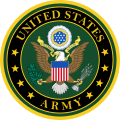Signal Corps Radios were U.S. Army military communications components that comprised "sets". Under the Army Nomenclature System, the abbreviation SCR initially designated "Set, Complete Radio", but was later misinterpreted as "Signal Corps Radio." [1]
Contents
- Nomenclature
- SCR radio sets
- SCS
- Additional designators
- SCR communication radios by branch use
- Radar
- See also
- References
- External links

